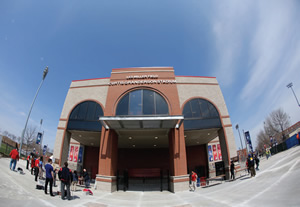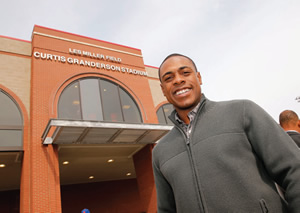A Campus Ballpark, A Community Asset

PHOTOS COURTESY OF THE UNIVERSITY OF ILLINOIS AT CHICAGO
Athletic directors, by nature, are fundamentally invested in the future of their facilities and campuses. These facilities play a role in recruiting; they impact the experience for fans; they help generate revenue for the university; and they shape what it means to be a student-athlete, a student or fan of a school. But it isn’t often that we get the opportunity to look beyond our campus when developing facilities and think strategically about the surrounding community. In April of 2014, the staff, fans and athletes at the University of Illinois at Chicago (UIC) saw this come to fruition. And it all started just two years prior, with an MLB All Star and UIC graduate who had a vision that was about much more than baseball.
A Loyal Graduate
Rewind two years. Curtis Granderson, outfielder for the New York Mets, committed $5 million to our university to build a new ballpark — a $10-million endeavor that would be located on the southeast corner of campus, replacing our aging existing ballpark. A loyal graduate and arguably the most talented (and philanthropic) athlete to be a UIC Flame, Curtis’ donation represented the single largest known donation from any professional athlete to his or her alma mater in history. His generosity has inspired others to give back — but it was his vision for the ballpark that was game changing.
He didn’t just want to create an enticing, fan-friendly home for the UIC Flames, although that was certainly part of it; Granderson envisioned something bigger — a facility that could become a catalyst for drawing inner-city kids to baseball, allowing them an opportunity to play in a minor-leaguecaliber stadium and learn from the best. Granderson, Coach Mike Dee and the university envisioned a place where UIC players mentored inner-city kids; a place where the campus melded with the community; and where we could develop young talent — giving them an outlet in baseball that they wouldn’t otherwise have access to. As the design process began, it became clear that this is a once-in-a-lifetime opportunity for UIC to fundamentally shift the momentum behind our program and to contribute to our community — who has long supported our endeavors — in a meaningful way.
A Community Asset
Just 63 percent of students in Chicago graduate from high school, and only 54 percent of Chicago students go on to attend college. Regardless of if they went on to play ball, our goal was to provide innercity kids — many of whom never consider a future that includes college — with an opportunity to step on a campus and to start to imagine a bigger, brighter future for themselves.

PHOTOS COURTESY OF THE UNIVERSITY OF ILLINOIS AT CHICAGO
HOMETOWN PROUD. The University of Illinois at Chicago earlier this year unveiled Curtis Granderson Stadium, funded in part by $5 million contributed by Granderson, a UIC Hall-of-Famer, three-time MLB All-Star and current outfielder for the New York Mets. “I’m thrilled to partner with my alma mater to provide the City of Chicago a state-of-theart facility in which our youth can play, learn and grow,” Granderson says. “UIC has played an integral role in shaping who I am as an athlete and as a person, so I’m confident that this facility will have a tremendous impact on our community.”
As the design process — led by architectural firm Populous — moved forward, we began to consider how the ballpark could be used beyond game day. Coach Dee connected with Little League teams, Chicago Public Schools and Major League Baseball to solidify programming opportunities and better understand how the stadium could serve the community. Partnerships with MLB’s Reviving Baseball in Inner Cities (RBI), local Little League teams and Curtis’ The Grand Kids Foundation were secured, and a design that melded with campus and represented our trajectory was solidified.
We also felt the stadium site was equally as important to the ballpark’s success. Located on the south side of campus, it connected most directly with the adjacent neighborhood — providing a direct access point for visitors. And beyond that, it featured arguably the best view in all of college baseball, one that looks like it could and should be a framed picture of the Chicago skyline. That site, and that stadium, have come to represent UIC. A beautiful campus in the middle of a beautiful city that has become a spot where baseball is not only attainable to watch for inner-city kids, but attainable to play.
“Curtis Granderson Stadium has already had a profound effect on the UIC campus and in our community. Many local and regional teams of boys and girls have played games, participated in clinics, or just visited the stadium as fans,” says Paula Allen-Meares, chancellor at UIC. “We take great pride in what the stadium provides in community service and engagement, and this pride is shared by our students, alumni, faculty and staff. It’s also a beautiful venue that is helping us draw fans — and recruits — to Flames Baseball.”
The Results
Since opening April 17th, the stadium, which seats 1,200 — and includes space for more than 500 on the grassy berm of the outfield, and features all the latest amenities — has served more than 40 Chicago-area community groups and 15,000 kids in just five months. The ballpark is constantly busy, and Curtis returned during the All-Star break to host youth clinics with UIC players and local NFL players. One of the organizations that has made use of the ballpark in that time period is U.S. Little League Champion team Jackie Robinson West — a local all-African-American Little League team that exemplifies what we intended the ballpark to be used for.
As an urban campus, we have a responsibility to our surrounding community and a true opportunity to use sports — our teams and our facilities — to do something special. Sports facilities on urban college campuses should go beyond the fan experience and revenue generation and consider their role as part of a larger strategic plan for partnerships between the community, university and athletic department. It is our hope that Curtis Granderson Stadium will be a model for future partnerships like this — shaping youth baseball in Chicago’s urban core while elevating the university’s athletic department and baseball program. It seems we’re already well on our way to doing so.
CURTIS GRANDERSON STADIUM
QUICK FACTS |
| Total Capacity |
1,784 (1,284 fixed, 500 berm) |
| Cost |
$10 million ($5 million contributed by Curtis Granderson) |
| Square Footage |
21,000 square feet |
| Club Seating |
28 fixed seats and 12 drink rail seats |
| Concessions |
Three points of sale within ballpark |
| Restroom Facilities |
One women’s facility with 12 fixtures and one men’s facility with 10 fixtures |
| Scoreboard |
18-foot-by-30-foot scoreboard, providing line score and color matrix board |
| Lighting |
Eight-pole system |
| Ticket Office |
Two ticket windows |
| Team Room |
Team room and video-review space of 485 square feet |
| Training Room |
New training room of 220 square feet |
| Practice Tunnels |
Two outdoor synthetic turf practice tunnels of 10 feet by 60 feet |
| Seating Berm |
Left and right field seating berms, accommodating 500 |
| Playing Surface |
Synthetic turf |
| Suite/Press Box |
New press box and suite. The press box is 340 square feet
and the suite is 1,980 square feet |
| Dugouts |
Home and visiting dugouts |
This article originally appeared in the issue of .